I’ll be honest, when I saw Registan Square in Kuala Lumpur’s Islamic Museum, I wasn’t just amazed at the architecture. I was actually really excited that Samarkand was a real place. I knew nothing about Uzbekistan, nor could I name a single city there – but years ago, I read a novel by Jonathan Stroud titled The Amulet of Samarkand. I’d just assumed it was one of those fantasy items, like something from a computer game called ‘the Sword of Glorious Wonders,’ or the ‘the Gauntlet of Zabadoodoo.’ I’d never even thought to look up the name ‘Samarkand’ to see if it was real. So when I read that it was, in fact, an actual city, I suddenly became a lot more interested in Uzbekistan. It was a bit like how I had to go to Shiraz, because it’s where the wine comes from, and Esfahan because of the jazz standard. I had to visit Samarkand one day.
Travelling through Uzbekistan is like travelling between different time periods. Each major city and region is different to the next, each being prominent in history in its own right. It’s like getting history lessons in snapshots, a few hundred kilometres apart.
When travelling eastbound, I think the escalation of the art and architecture really added to our trip. Our first stop was Khiva, a city of bricks. What stands today is actually fairly recent history wise, but because Khivans stuck to their older traditions in architecture and art, the city looked deceptively old – or perhaps I was just ignorant enough about Uzbekistan to believe it! Though there are still the classic blues used throughout the city, and some very impressive tile work, the city is definitely more of a sandy yellow colour compared with its neighbours.
Khiva is more like a town than a city, a quiet little end of Uzbekistan where kids run around in the streets and play on bikes, while a baby goat had the time of its life jumping up and down the old city walls opposite. Despite the heat, it was nice to wander around the place. This was the seat of the Khiva khanate, and it’s easy to imagine that life has not changed significantly for centuries. My initial judgement was in fact wrong, as most of the city was rebuilt in the 1800-1900s, but it has the kind of mud-brick city feel to it, as if the locals decided the way it was done in the first millennium was the best way for it stay.
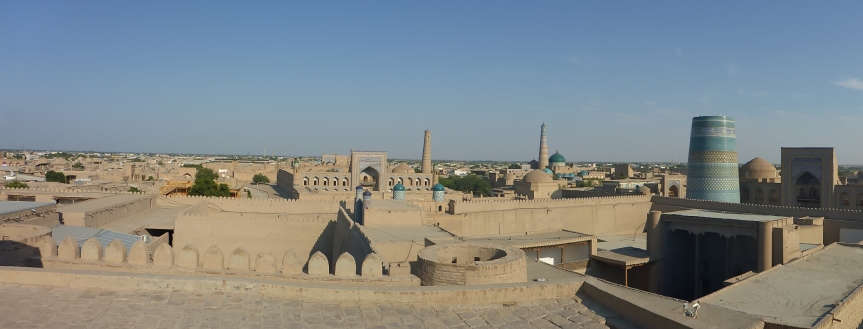
Khiva was also our first introduction to the Uzbek traditions of hospitality. In a restaurant in the old city after sundown, our Uzbek feast was laid out with flatbread, fresh salads, the staple Uzbek soup, and the main dishes of shashliks, green herb pasta, or Uzbek dumplings. Each of us were given our own teacups, roughly the size of a Asian rice bowl. Here, it is rude to completely fill a tea cup to the top. It’s considered respectful to leave about a quarter of the bowl/cup, wether pouring for yourself or serving others. Another interesting etiquette is to not turn your bread upside down. The ‘correct’ side up is the side with a pattern stamped into it, usually in the centre. And the last of our lessons was that Uzbeks do not have a word for ‘thankyou’ in their language, and it’s considered weak to thank people!
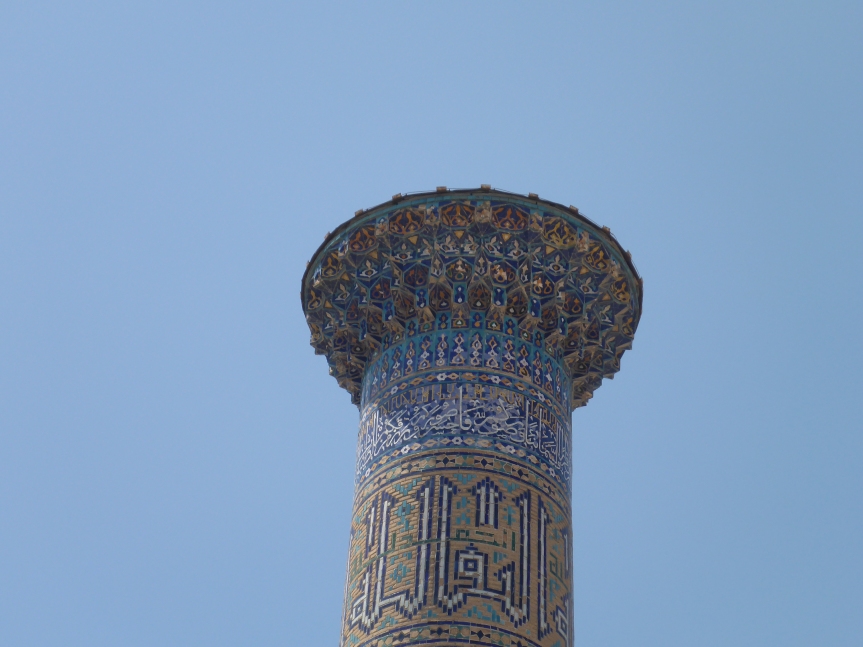
Our next stop along the silk road was one of Uzbekistan’s two most famous cities. Bukhara is a mix of everything. It has one of the most impressive collections of historical buildings and monuments. I think that was what was so amazing about the city, the surprising mix of cultures and histories, from ancient to modern. I was expecting only Islam, but there was a little Judaism, Christianity, Zoroastrinism, and some Mongols thrown in too.
Bukhara hosts some of the best examples of architecture from the pre-Mongol era, as well as the 16th and 17th centuries. There are also some hints of Uzbekistan’s Zoroastrian heritage, found in some of the symbols carved into it’s buildings. It was nice to recognise some of these from my time in Iran – proof I’ve learnt something! I also hadn’t heard of the “miracle of Job,” where the prophet Job supposedly placed his staff into the ground and created a spring. There is now a shrine where believers can pay respects and collect some of the water. There’s a Jewish quarter too, home to Bukharan Jews (later well-known to have emigrated in the Soviet era, who have made substantial communities in the US and Israel).
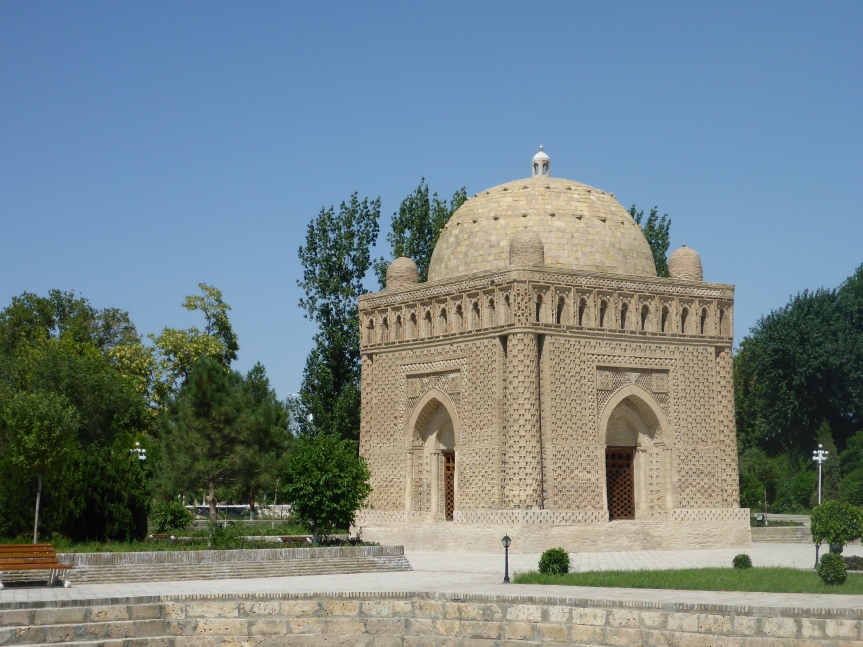
The ‘Jewel of Bukhara,’ a crypt for the 9th century Samanid Dynasty. Interestingly, construction on the site of burial was against Islamic law at the time, and is therefore one of the earilest surviving examples of Islamic mausoleums. It’s decorated with famous Bukharan brick work, and covered with Zoroastrian symbols.
Bukhara was famed for it’s decorative brickwork, something that sets it apart from all other cities. Impressively, it’s minaret built in the 11th century withstood the Mongol invasion, during which most other buildings were razed. Locals took it as a sign from God, and it’s one of the city’s icons.
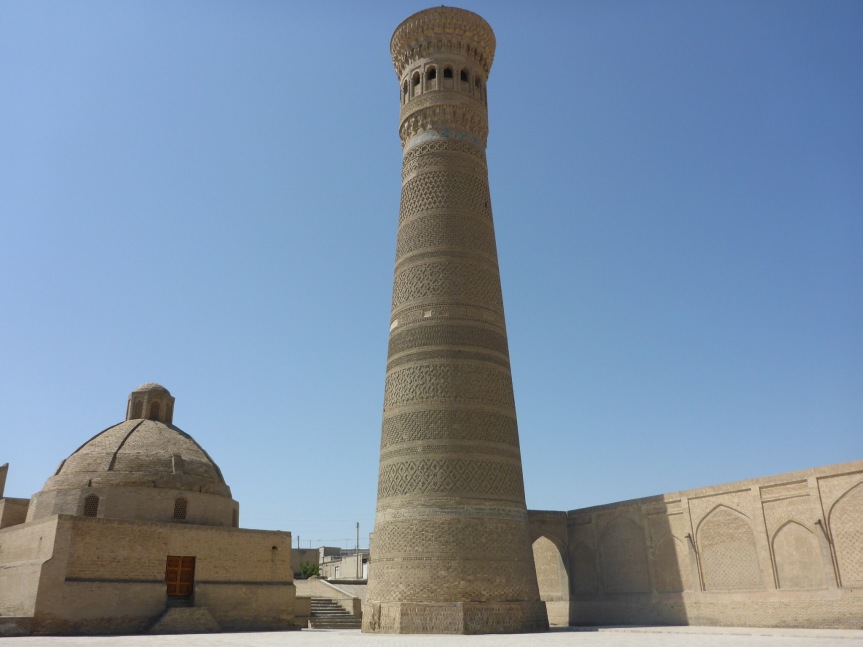
Samarkand is the crowning jewel of the country, home to Registan Square. This is the country as it’s best, it’s most impressive. The scale of buildings, the detail of the art, all made to awe. It is the city of Tamarlane (or Timur, Temur and Timur the Lame), who made it his capital, and from there conquered so much of the world. It’s also one of the oldest cities of the Silk Road, though most of it’s buildings are from the 13th -16th century.
The best thing I enjoyed about Registan Square was just sitting in the courtyards of the mosques. I listened a while to our guide, trying to absorb as much information as I could at first, but then I just took the time to sit on a bench and enjoy the quiet. I love this kind of geometric Islamic art, and there are always more tiny little details to discover the longer you look. After having put Samarkand on my bucket list a few years ago, it definitely lived up to its name.
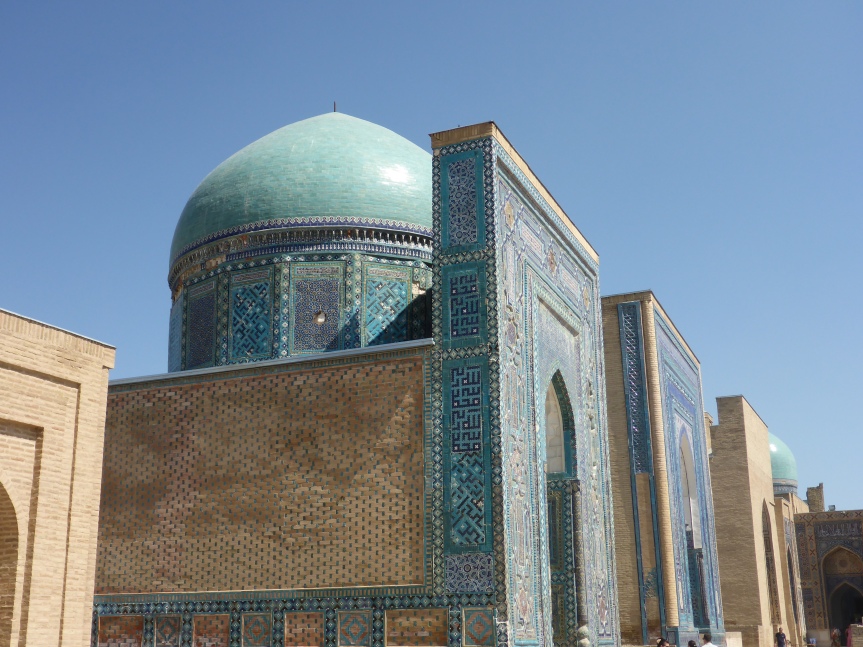
It’s difficult to fit all the significant monuments of Samarkand and Bukhara in just a few days, particularly in the stifling heat. At one point, I think our whole group’s eyes glazed over, and we all couldn’t remember the name of the building we were in, let alone retain any sentence about it’s significance. Thankfully, because of government policy, we had to stay in registered hotels in Uzbekistan – and one even had a pool! The only time I’d been more grateful to jump into a pool was probably while we were sweating on the Caspian Sea.
Tashkent represents the country’s Soviet history. There are few buildings several hundred years old, and those that are mostly connected with the Russian conquerors who came through and included it in their empire in the 18th century. The Subway is great to explore, each station having it’s own theme. Some celebrate certain writers, one celebrated the Uzbek Cosmonauts who were involved in the space race. The best thing is that there’s no advertising, so the art has stayed the same, with no marketing blocking the view.
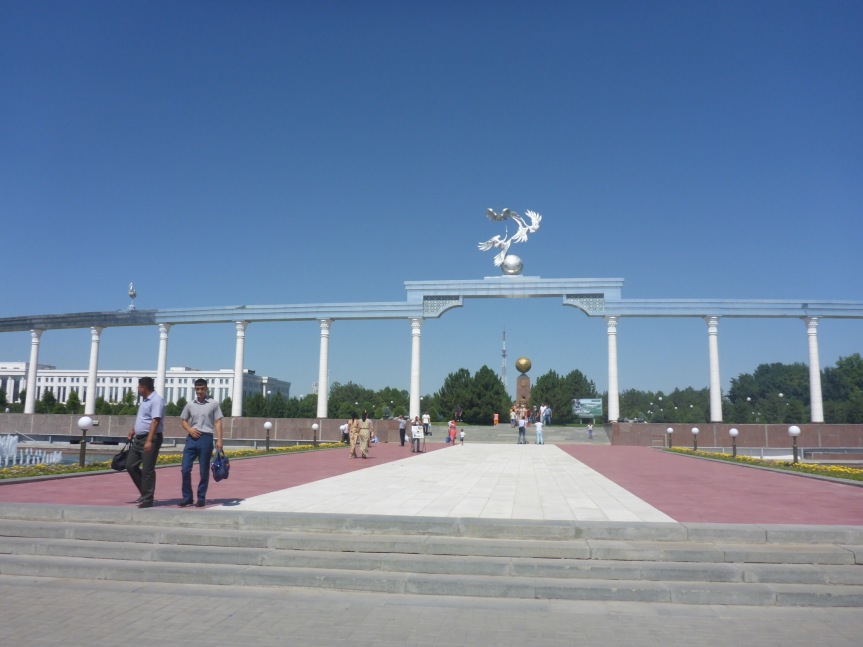
Tashkent’s main park, where we were re-routed due to the Prime Minister (now President) being nearby.
On the other hand, getting in and out of the subway stations involved security checks, and at one particular station there was even a huge dog. Ironically, there didn’t really seem to be enough people around to warrant said security measures, though perhaps we were just there on a quiet day. We were actually told when walking through the main park that we couldn’t walk in a certain area because the Prime Minister was nearby, and not so subtly followed around the rest of the time we were in the park. It felt so different to all other places we’d been to.
It was at that point that I realised we had probably been followed for most of our trip, and noticed just how careful our guide was having to be. There was a lot of suspicion, something I’d not noticed in any other place. I knew there were restrictions in the country, but I’d not realised just how tight the government’s control was. I guess that was the result, or perhaps the cause, of protests against the government in the heavily religious Ferghana valley (which I’ll go into more detail about later).
Interestingly, when we were there, there were concerns about the President, whose health was rumoured to be bad. They weren’t really allowed to talk about it. About 2 months after we left, said President died. It made the news as a small ticket tape on CNN and BBC world news, but I’ve heard little else about it. The Prime Minister became the interim President, and was voted into office just last month. It would be interesting to see if anything changes! But as is the way with our media, and probably also the censoring in Uzbekistan, I doubt there will be very much in English language news regarding any possible changes in a country the West knows so little about.
Getting to the Fergana valley was an adventure! We had to travel by an envoy, rather than our beloved tuck, due to the strict licensing and high security on the pass to get in. This is one of the so-called ‘trouble’ areas, where they have been protests against the government in the past. It was also some of the most terrifying and amusing driving I’ve ever seen.
Along the high way there are concrete barriers, as is normal on mountain highways round the world. Only, in Uzbekistan, the have gaps in between them. Sometimes for a few metered, sometimes ten. These were not just on the edge of the road, but between each lane of the 3-4 lane highway. So, when trying to overtake other vehicles, people were speeding up, switching lanes, and then having to get back into the correct one in between these barriers. Add to that some terrible hyped up electro rave music booming from the car stereo, and you’ve got some MarioKart-esque moves. I wish I could have filmed some of the insane moves we saw, and the crazy drivers attempting the impossible, but sadly no photos or videos are allowed on the pass for security reasons.
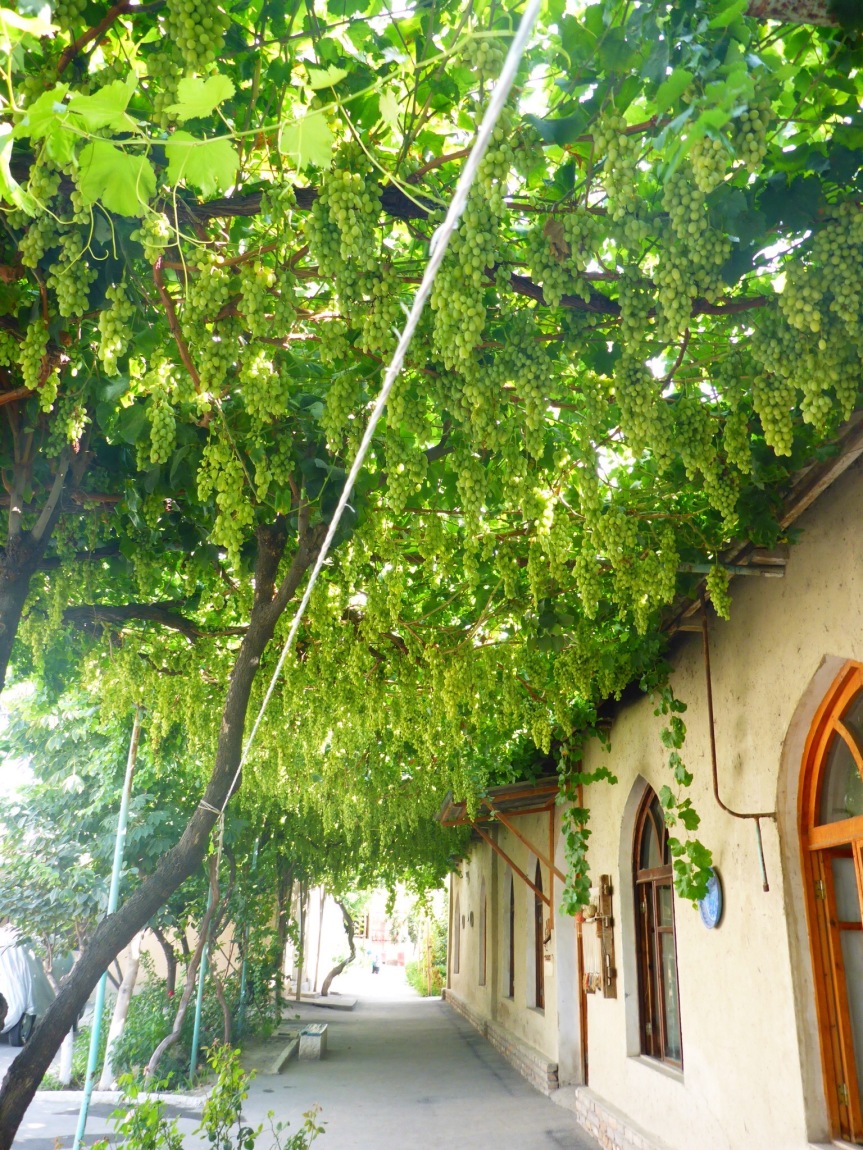 Fergana itself is a gorgeous area, with mountains and green valleys. This is the foodbowl of the country, a complete contrast to the dusty and sandy desert cities over in the east. We drove through one area, quite close to the border, where each house seemed to have it’s own grape-vine trellis. It looked a little more like a town from the Azeri mountains, or the Georgian wine region, compared to cities like Khiva! The Khan’s palace is certainly reminiscent of Sheki’s equivalent on the inside(read about Azerbaijan Here), though very much Uzbek on the outside.
Fergana itself is a gorgeous area, with mountains and green valleys. This is the foodbowl of the country, a complete contrast to the dusty and sandy desert cities over in the east. We drove through one area, quite close to the border, where each house seemed to have it’s own grape-vine trellis. It looked a little more like a town from the Azeri mountains, or the Georgian wine region, compared to cities like Khiva! The Khan’s palace is certainly reminiscent of Sheki’s equivalent on the inside(read about Azerbaijan Here), though very much Uzbek on the outside.
The area is meant to be contentious – it’s is listed by the Australian government as ‘reconsider your need to travel,’ some are even that you shouldn’t travel there at all. But we didn’t notice anything to suggest anything unsafe (though after Tashkent, I wouldn’t be surprised if we were followed a few times). The main difference in the people we saw was that more women here wore headscarves. That was it. At one point, in a kind of round about way only mentioned in between locals walking in and out of earshot, our guide guide explained the issues surrounding the Muslim population. Bearing in mind, that the country has a proud Islamic history, and was once one of the greatest Islamic empires, and the builders of all those madrasa, mosques and minarets we’d just seen (one of which we were sitting in as he mentioned all this). The government had issues with the religious leaders, as they had influence where they did not. I’m still unclear if this was before the initial clashes with the government, or if the targeting happened after the protest outbursts, and it has been somewhat difficult to find objective English media.
Above: The Khan’s palace in Ferghana.
Nonetheless, Muslims and the Uzbek government have not been getting on in recent years, particularly in Ferghana, where the government faced a lot of opposition and had clashes with locals. These local groups happen to be Muslim, though promoting their religious values was not their only agenda. So, the government came up with very strict laws about practicing Islam or any other religion, not least of all making it difficult to attend a mosque regularly without the authorities having security files on you. One move that caused an outcry was the closure of the Kyrgyz border, which crippled the local economy, and resulted in hundreds of protesters being killed by troops. On the other hand, Uzbekistan has had relatively few outbreaks of violent protest against the regime in recent years, giving the nation stability.
But it felt so strange, because other than the high level of security on the Ferghana pass, (partly due to the important dam and what looked like electrical power stations) the atmosphere of the valley itself was the complete opposite to all of this political background. Friendly people were just going about their lives, as they would any summer. But then of course, there would be things under the surface we’d never know about from just passing through.
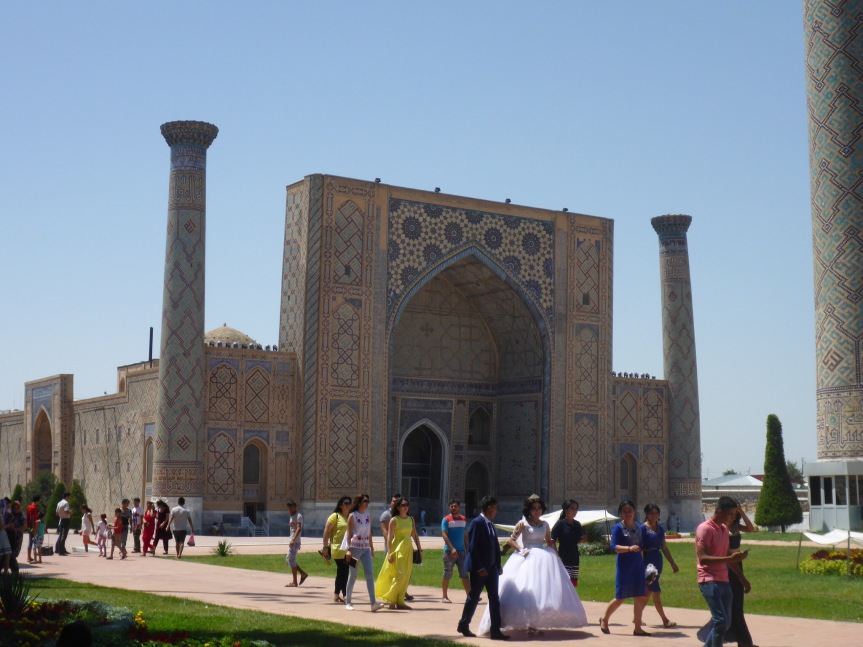
Many of the monuments we visited had couples taking wedding photos outside. Brides are not allowed to smile during this tradition, ir order to show the ‘seriousness’ of the occassion.
So that was it, a little glimpse of Uzbekistan’s timeline, from Zoroastrianism and Persians, to khanates and cities competing for power, to Mongols, to Timur’s conquering, to Soviet empires, and finishing up with very recent history in Ferghana. A quick little snapshot of centuries of culture, to prove Uzbekistan’s cities aren’t just the stuff of fantasy novels












